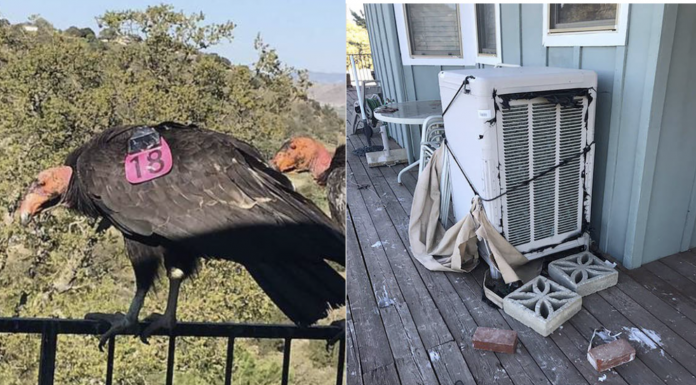TEHACHAPI, Calif. (AP) — Giant California condors are rare — but not at Cinda Mickols’ home.
About 15 to 20 of the giant endangered birds have recently taken a liking to the house in the city of Tehachapi and made quite a mess.
Mickols’ daughter, Seana Quintero of San Francisco, began posting photos of the rowdy guests on Twitter.
She told the San Francisco Chronicle the birds showed up at her mother’s home sometime last weekend.
The birds have trashed the deck — ruining a spa cover, decorative flags and lawn ornaments. Plants have been knocked over, railings scratched and there’s poop everywhere.
“When it comes to birds, there may be more than just avian flu to be worried about … [T]here are over 60 other diseases that birds and their droppings can carry. The problem is especially worrisome in residential areas, as many of them are airborne and can be transferred to humans just by being around droppings.” – Medical News Today
“She’s definitely frustrated but also is in awe of this and knows what an unusual experience this is,” Quintero said of her mother.
The U.S. Fish and Wildlife Service, which runs a program to save the species from extinction, responded on Twitter. The agency noted that the house is in historic condor habitat, and suggested that Mickols try harmless hazing like shouting and clapping or spraying water.
“It is not unusual to see large congregations of condors in certain high use areas like the region where this incident occurred,” especially when feeding, Fish and Wildlife spokeswoman Pam Bierce said in an email. “Unfortunately, they sometimes perceive houses and decks as suitable perch locations.”
California condors almost vanished in the 1980s before the few remaining birds were captured and placed in zoos for captive breeding.
A few hundred birds are now in the wild. As condors re-colonize parts of their historical range, people could increasingly find themselves interacting with the “curious, intelligent, social” birds, Bierce said.
Kill A Condor, Go To Jail
Condor shooting under investigation in California; reward offered for information
September 19, 2018
Division of Public Affairs
Telephone: 703-358-2220
The U.S. Fish and Wildlife Service is investigating a second case involving the shooting of an endangered California condor.
The condor was found dead on private property in Porterville, California in May 2018. The property is located south of Hot Springs Road and east of Old Stage Coach Road in Tulare County. The Service’s Wildlife Forensics Laboratory conducted a necropsy and determined the cause of death to be trauma from a gunshot wound.
The other case under investigation involves a condor that was found fatally shot on a remote private property in Kern County in July 2018.
Anyone with information regarding the shooting of this condor can contact the Service’s Office of Law Enforcement in Sacramento, California at 916-569-8476. Callers with information may remain anonymous. The Service is offering up to a $5,000 reward for information leading to the conviction of the person or persons responsible for the shooting of this condor.
California condors were listed as endangered under the Endangered Species Act in 1967. In the 1980s, condor numbers reached a low of only 23 individuals worldwide. Intensive recovery and reintroduction efforts over the past three decades have brought the California condor population up to approximately 400 individuals.
California condors are protected by the Endangered Species Act and the Migratory Bird Treaty Act. Taking, shooting, injuring, or killing a condor are violations of these acts. The maximum penalty for a criminal violation of the Endangered Species Act is one year in jail and a $100,000 fine per individual (or $200,000 per organization). The Migratory Bird Treaty Act carries maximum penalties ranging from six months to one year in jail and fines up to $250,000 per individual, depending on whether an individual is convicted of a misdemeanor or a felony.
The U.S. Fish and Wildlife Service works with others to conserve, protect, and enhance fish, wildlife, plants, and their habitats for the continuing benefit of the American people.



